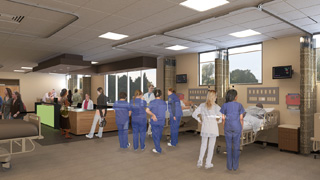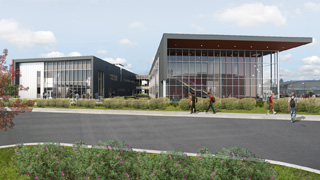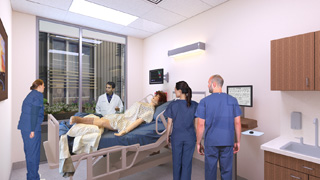|
Subscribe / Renew |
|
|
Contact Us |
|
| ► Subscribe to our Free Weekly Newsletter | |
| home | Welcome, sign in or click here to subscribe. | login |
Construction
| |
 |
July 26, 2012
Simulations playing wider role in nursing education
McGranahan Architects

Olson
|
There is little doubt that our current health care system has placed increased pressure on providers to deliver patient care in a safe, effective and efficient manner.
A well-educated and dedicated team of nurses and caregivers is essential to meet these goals. The development of simulation programs in both educational and acute care settings is addressing the challenge to maintain this valuable nursing resource.
The Washington Center for Nursing, or WCN, reported in January that the weak economy has delayed an expected nursing shortage because many veteran nurses have put off retirement and others have taken on additional shifts or moved from working part time to full time. That conclusion is based on information from a University of Washington School of Medicine report WCN commissioned that studied supply and demand projections for registered nurses in our state.
The workforce continues to age and our state’s population growth, coupled with increased access to health care brought about by the Affordable Care Act, will result in nursing demand outpacing supply over the next decade. To address this coming shortage WCN recommends graduating more nurses and improving workforce retention.
One complication for nursing education is that the traditional “learning by doing” model has been impacted by shorter hospital stays and a shift to outpatient treatment for many procedures. Simulation programs have stepped in to bridge this gap and relieve the pressure on overextended nursing programs.
Simulation elements
Health care simulation is coming of age, having learned much from established simulation methodologies used in aviation, space flight, nuclear power and military applications. The National Council of State Boards of Nursing (NCSBN) reports that 87 percent of nursing schools have incorporated patient care simulation into their curriculum.
Simulation includes a wide range of activities that share the common purpose of improving patient safety, increasing the effectiveness of health care delivery, and providing learning opportunities in a risk-free and supportive environment.
Elements of a simulation program vary. Examples include the use of “standardized patients” (actors trained to present certain symptoms); low-fidelity, non-mechanical mannequins designed to practice skills; and high-fidelity, computerized human patient simulators that can cost more than $70,000.
Although the investment in equipment and space can be considerable, simulated learning has a number of advantages. They include the ability to experience a crisis situation on demand with no harm to a patient; the ability to expose every student to the same clinical experience, reducing training variability; and the ability to provide immediate feedback on performance in a controlled, non-threatening environment.
Beyond the teaching environment, simulation techniques are used to observe team interaction and develop improved collaboration within multidisciplinary teams.
Keys to success
A few key design concepts have been drawn from the review of successful simulation environments:
Location. Whether in an academic or institutional setting, a simulation center brings together multiple disciplines. A location that is highly visible and easily accessible will build on the collaborative nature of the experience and will promote higher utilization of the space.
Flexibility. The ability to adapt to new equipment, advances in technology and program changes is essential. Shared or reconfigurable support spaces and defined paths for future expansion should be considered.
Access to debriefing spaces. Adjoining debriefing spaces are essential to facilitate the learning process that happens after the clinical exercise. Real-time audio and video capacity should be available in these spaces as well.
Accurate patient care spaces. Duplicating all equipment and furnishings found in the true patient care setting is critical to a realistic simulation. Room dimensions and layout should also be the same.
Opportunities for interaction. Providing breakout or mixing spaces that foster interaction between team members or informal conversations between students and instructors will enhance the learning experience for all.
Clover Park Technical College
The new Health Sciences Building at Clover Park Technical College in Lakewood offers an example of the expanded role of simulation environments in health training programs. The building is currently under construction. McGranahan Architects is the designer and Jody Miller Construction is the general contractor. Completion is scheduled for spring of 2013.
At nearly 56,000 square feet, the Health Sciences Building is more than double the size of the school’s existing facilities and will bring together 11 health training programs, accounting for 2,166 full-time-equivalent students.
The building is designed as a pair of two-story wings joined near one end by a transparent connector containing lounge/study alcoves and a connecting stair. At the opposite end of each wing, a wall of glass defines a double-height space containing an open stair with student and faculty study areas.
The northern wing houses a combination of flexible classrooms, lecture halls and computer labs. The second floor includes a large open-plan faculty suite.
The first floor of the building’s southern wing houses the primary simulation spaces, which include two nursing labs with a total of 26 typical treatment stations, a clinic pod with three exam rooms, two simulated operating rooms with an adjoining substerile room, and a central service area for decontamination, processing and storage. Above the simulation spaces are two integrated science labs as well as specialized labs for pharmacy, histology, hemodialysis and medical lab tech programs.
In addition to providing teaching labs and simulation spaces, the Health Sciences Building supports interaction between disciplines through shared labs and numerous collaboration spaces, as well as open lounge and study alcoves clustered around primary circulation nodes.
The building promotes the concepts of healing and well-being, offering abundant natural daylight, views of the landscaped courtyard and green roof gardens with medicinal plantings. The building is on track to achieve LEED silver certification.
Research under way
Studies on the effectiveness of simulation as a substitute for clinical experience are somewhat limited.
The NCSBN has recently begun the most comprehensive study on this subject to date. It will explore the role and outcomes of simulation in education by monitoring the clinical performance of nursing students from their first day of nursing school through graduation and into their first year of practice.
Ten sites — five offering associate degree nursing programs and five with baccalaureate degree programs — began monitoring incoming students in the summer of 2011. The goal is to highlight current best practices in simulation use, evaluate the effectiveness of varying amounts of simulation as a substitute for direct patient care in clinical settings, and establish simulation standards and learning experiences for core clinical courses. Final data collection will be complete in December 2014.
While the empirical evidence is still being collected, the increasing sophistication of simulation tools and the need for nursing professionals suggests that simulation environments will continue to play an expanding role in health care education.
Todd Olson brings over 25 years of medical programming, planning and design experience to the position of director of health care at McGranahan Architects.
Other Stories:
- Lean design is different for every health care project
- Former TV studio remodeled into dialysis clinic
- Silverdale hospital sets ambitious budget for new wing
- Virtual tools put Everett tower on the fast track
- Clinic designs evolving to meet growing list of needs
- Hospital’s mechanical design process a complex dance
- When hospitals expand, traffic concerns follow
- Tight UW site left nowhere to go but up
- Builder’s challenge: Keep UW hospital running smoothly





